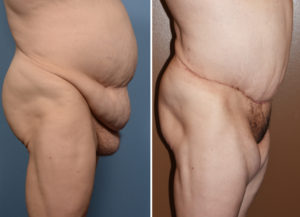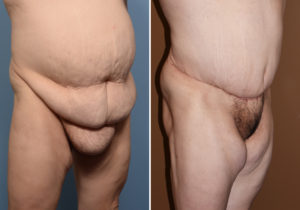Background: Large amounts of weight loss are very good for one’s health and are to be commended whether they are achieved by self-induced weight loss or bariatric surgery. But one of the common sequelae of such weight loss is loose skin which appears as low hanging rolls around the torso. The most common torso roll on the ventral body surface is the abdominal pannus. This apron of skin and fat hangs over the waistline and often drapes onto the upper thighs and is the reason for abdominal panniculectomy procedure which it is removed.
While some abdominal pannuses are a single roll overhang, others may have a double roll. The double roll occurs because excessive abdominal tissue above the umbilicus ‘catches’ on the stalk’s attachment and forces it to build up above it. (just like snow blowing up against a fence) The double roll abdominal pannus requires that the abdominal wall be disinserted from the umbilicus to allow it to be mobilized inferiorly (unfurled) so that maximal abdominal tissue can be removed. (both rolls to be removed)
In more uncommon abdominal pannuses a third roll may develop but it does not come from the abdominal wall. This third and lowest roll comes from the pubic mound. When the pubic mound gets big enough, it will be pushed down by the true abdominal pannus creating the triple roll effect. Technically this may be called the pubic pannus as it represents an excess of skin and fat, just like an abdominal pannus.
Case Study: This middle-aged female lost a lot of weight on her own. But due to her short body frame and shape this resulted in three rolls on her abdominal area. Most impressive was the size of her pubis which hung down onto her inner thighs and obstructed her urethra and urinary outflow.


Case Highlights:
1) While an abdominal pannus is a common sequelae of weight loss, a true pubic pannus is much more uncommon.
2) A ‘triple roll’ abdominal wall deformity includes a double abdominal roll and a lower pubic roll.
3) In a triple roll abdominal panniculectomy a concomitant pubic lift with liposuction is needed.
Dr. Barry Eppley
Indianapolis, Indiana



